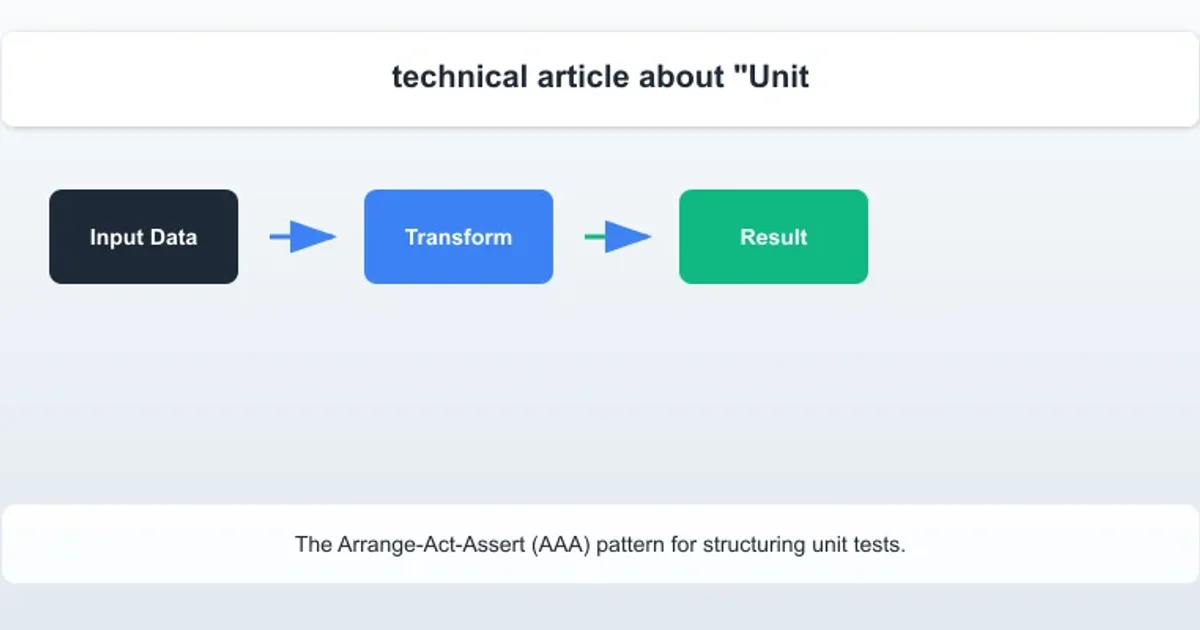Unit testing large blocks of code (mappings, translation, etc)
Categories:
Unit Testing Large Blocks of Code: Mappings, Translations, and ETL

Learn effective strategies and patterns for unit testing complex code blocks like data mappings, translations, and ETL processes in C#, ensuring reliability and maintainability.
Unit testing is a cornerstone of robust software development. However, when dealing with large blocks of code responsible for intricate data mappings, translations, or Extract, Transform, Load (ETL) processes, traditional unit testing approaches can become cumbersome and ineffective. This article explores practical strategies and patterns for effectively unit testing these complex components, focusing on C# examples, to ensure data integrity, correctness, and maintainability.
The Challenge of Testing Complex Transformations
Large mapping or translation functions often involve multiple steps: data extraction, validation, transformation rules, and loading. These processes can be highly dependent on external data sources, configuration, or business rules, making them difficult to isolate and test. The primary challenges include:
- Isolation: How do you test a transformation logic without needing a full database or external API?
- Complexity: Many conditional branches and data permutations can lead to an explosion of test cases.
- Maintainability: As business rules evolve, tests must be easy to update without breaking existing functionality.
- Readability: Tests should clearly articulate the expected input and output, making them easy to understand.
flowchart TD
A[Raw Source Data] --> B{Extract Data}
B --> C{Validate Data}
C --> D{"Apply Transformation Rules (Mapping/Translation)"}
D --> E{Load Transformed Data}
E --> F[Target System]
subgraph Unit Testing Focus
C -- Test Isolation --> D
end
D -- Many Paths --> G[Complex Logic]
G -- Requires --> H["Extensive Test Cases"]
H -- Goal --> I["Ensure Correctness & Maintainability"]Typical ETL/Data Transformation Flow and Unit Testing Focus
Strategy 1: Decompose and Isolate
The most effective way to test large blocks of code is to break them down into smaller, more manageable units. This adheres to the Single Responsibility Principle (SRP) and makes each component easier to test in isolation. For data mappings and translations, consider:
- Input Validation: Separate functions or classes for validating raw input data.
- Atomic Transformations: Break down complex transformation rules into individual, testable functions (e.g.,
FormatDate,CalculateDiscount,MapStatusCode). - Orchestration Logic: A higher-level component that orchestrates the sequence of validation and transformation steps.
By isolating these concerns, you can write focused unit tests for each small piece, ensuring its correctness before integrating it into the larger process.
public class OrderMapper
{
private readonly IProductService _productService;
public OrderMapper(IProductService productService)
{
_productService = productService;
}
public TargetOrder Map(SourceOrder source)
{
if (source == null) throw new ArgumentNullException(nameof(source));
if (!IsValidSourceOrder(source)) throw new InvalidOperationException("Invalid source order.");
var targetOrder = new TargetOrder
{
OrderId = source.Id.ToString(),
CustomerName = FormatCustomerName(source.FirstName, source.LastName),
OrderDate = ParseOrderDate(source.OrderDateString),
TotalAmount = CalculateTotal(source.Items)
};
// Example of calling a dependency
foreach (var item in source.Items)
{
var product = _productService.GetProductDetails(item.ProductId);
targetOrder.LineItems.Add(new TargetLineItem
{
ProductId = product.Id,
ProductName = product.Name,
Quantity = item.Quantity
});
}
return targetOrder;
}
private bool IsValidSourceOrder(SourceOrder source)
{
// Complex validation logic here
return !string.IsNullOrWhiteSpace(source.FirstName) && source.Items != null && source.Items.Any();
}
private string FormatCustomerName(string firstName, string lastName)
{
return $"{firstName} {lastName}".Trim();
}
private DateTime ParseOrderDate(string dateString)
{
if (DateTime.TryParse(dateString, out var date)) return date;
throw new FormatException("Invalid date format.");
}
private decimal CalculateTotal(IEnumerable<SourceItem> items)
{
return items.Sum(item => item.Price * item.Quantity);
}
}
// Example of a simple interface for dependency injection
public interface IProductService
{
Product GetProductDetails(string productId);
}
public class Product
{
public string Id { get; set; }
public string Name { get; set; }
public decimal Price { get; set; }
}
public class SourceOrder { /* ... properties ... */ }
public class SourceItem { /* ... properties ... */ }
public class TargetOrder { /* ... properties ... */ }
public class TargetLineItem { /* ... properties ... */ }
Example of a decomposed C# OrderMapper class with isolated methods.
OrderMapper above can have its own dedicated unit tests.Strategy 2: Mocking and Stubbing Dependencies
For components that rely on external services, databases, or file systems, mocking and stubbing are indispensable. This allows you to control the behavior of dependencies during tests, ensuring that your unit tests only focus on the logic within the component under test, not its collaborators.
- Mocks: Objects that record calls made to them, allowing you to verify interactions (e.g.,
Was this method called with these arguments?). - Stubs: Objects that provide canned responses to method calls, simulating specific scenarios (e.g.,
When GetProductDetails is called, return this specific product).
Using a mocking framework (like Moq for C#) simplifies this process significantly.
using Moq;
using Xunit;
public class OrderMapperTests
{
[Fact]
public void Map_ValidSourceOrder_ReturnsCorrectTargetOrder()
{
// Arrange
var mockProductService = new Mock<IProductService>();
mockProductService.Setup(s => s.GetProductDetails("P1"))
.Returns(new Product { Id = "P1", Name = "Laptop", Price = 1000m });
mockProductService.Setup(s => s.GetProductDetails("P2"))
.Returns(new Product { Id = "P2", Name = "Mouse", Price = 25m });
var mapper = new OrderMapper(mockProductService.Object);
var sourceOrder = new SourceOrder
{
Id = Guid.NewGuid(),
FirstName = "John",
LastName = "Doe",
OrderDateString = "2023-01-15",
Items = new List<SourceItem>
{
new SourceItem { ProductId = "P1", Quantity = 1, Price = 1000m },
new SourceItem { ProductId = "P2", Quantity = 2, Price = 25m }
}
};
// Act
var targetOrder = mapper.Map(sourceOrder);
// Assert
Assert.NotNull(targetOrder);
Assert.Equal(sourceOrder.Id.ToString(), targetOrder.OrderId);
Assert.Equal("John Doe", targetOrder.CustomerName);
Assert.Equal(new DateTime(2023, 1, 15), targetOrder.OrderDate);
Assert.Equal(1050m, targetOrder.TotalAmount); // 1*1000 + 2*25
Assert.Equal(2, targetOrder.LineItems.Count);
Assert.Contains(targetOrder.LineItems, li => li.ProductId == "P1" && li.ProductName == "Laptop" && li.Quantity == 1);
Assert.Contains(targetOrder.LineItems, li => li.ProductId == "P2" && li.ProductName == "Mouse" && li.Quantity == 2);
// Verify interactions with the mock
mockProductService.Verify(s => s.GetProductDetails("P1"), Times.Once);
mockProductService.Verify(s => s.GetProductDetails("P2"), Times.Once);
}
[Fact]
public void Map_InvalidOrderDate_ThrowsFormatException()
{
// Arrange
var mockProductService = new Mock<IProductService>();
var mapper = new OrderMapper(mockProductService.Object);
var sourceOrder = new SourceOrder
{
Id = Guid.NewGuid(),
FirstName = "John",
LastName = "Doe",
OrderDateString = "INVALID_DATE", // Invalid date format
Items = new List<SourceItem> { new SourceItem { ProductId = "P1", Quantity = 1, Price = 10m } }
};
// Act & Assert
Assert.Throws<FormatException>(() => mapper.Map(sourceOrder));
}
// ... more tests for edge cases, null inputs, empty lists, etc.
}
Unit tests for OrderMapper using Moq for IProductService dependency.
Strategy 3: Data-Driven Testing for Mappings
When dealing with many input-output permutations for mappings or translations, data-driven testing (also known as parameterized tests) can significantly reduce boilerplate code and improve test readability. Instead of writing a separate test method for each scenario, you provide a set of test data, and the test runner executes the same test logic with different inputs.
In C#, xUnit.net provides excellent support for data-driven tests using [InlineData], [MemberData], or [ClassData] attributes.
using Xunit;
public class DataTransformationTests
{
// Test for a simple translation function
[Theory]
[InlineData("USD", "US Dollar")]
[InlineData("EUR", "Euro")]
[InlineData("GBP", "British Pound")]
[InlineData("", "Unknown Currency")]
[InlineData(null, "Unknown Currency")]
public void TranslateCurrencyCode_ReturnsExpectedName(string code, string expectedName)
{
// Arrange
var translator = new CurrencyTranslator();
// Act
var actualName = translator.TranslateCurrencyCode(code);
// Assert
Assert.Equal(expectedName, actualName);
}
// Test for a more complex mapping with multiple inputs
[Theory]
[MemberData(nameof(GetTestDataForComplexMapping))]
public void ComplexMapping_ReturnsExpectedResult(SourceData input, ExpectedResult expected)
{
// Arrange
var mapper = new ComplexDataMapper();
// Act
var actual = mapper.Map(input);
// Assert
Assert.Equal(expected.OutputValue, actual.OutputValue);
Assert.Equal(expected.Status, actual.Status);
}
public static IEnumerable<object[]> GetTestDataForComplexMapping()
{
yield return new object[]
{
new SourceData { Value1 = 10, Value2 = 5, Type = "Add" },
new ExpectedResult { OutputValue = 15, Status = "Success" }
};
yield return new object[]
{
new SourceData { Value1 = 20, Value2 = 10, Type = "Subtract" },
new ExpectedResult { OutputValue = 10, Status = "Success" }
};
yield return new object[]
{
new SourceData { Value1 = 100, Value2 = 0, Type = "Divide" },
new ExpectedResult { OutputValue = 0, Status = "Error: Division by zero" }
};
// Add more test cases for different scenarios
}
}
public class CurrencyTranslator
{
public string TranslateCurrencyCode(string code)
{
return code?.ToUpper() switch
{
"USD" => "US Dollar",
"EUR" => "Euro",
"GBP" => "British Pound",
_ => "Unknown Currency"
};
}
}
public class SourceData { public int Value1 { get; set; } public int Value2 { get; set; } public string Type { get; set; } }
public class MappedResult { public int OutputValue { get; set; } public string Status { get; set; } }
public class ExpectedResult { public int OutputValue { get; set; } public string Status { get; set; } }
public class ComplexDataMapper
{
public MappedResult Map(SourceData data)
{
var result = new MappedResult();
switch (data.Type)
{
case "Add":
result.OutputValue = data.Value1 + data.Value2;
result.Status = "Success";
break;
case "Subtract":
result.OutputValue = data.Value1 - data.Value2;
result.Status = "Success";
break;
case "Divide":
if (data.Value2 == 0)
{
result.OutputValue = 0;
result.Status = "Error: Division by zero";
}
else
{
result.OutputValue = data.Value1 / data.Value2;
result.Status = "Success";
}
break;
default:
result.OutputValue = 0;
result.Status = "Error: Unknown operation";
break;
}
return result;
}
}
Data-driven tests using xUnit's [InlineData] and [MemberData] attributes.
[ClassData] or custom DataAttribute implementations to load test cases dynamically.Best Practices for Testing ETL and Mapping Logic
Beyond specific strategies, adhering to general best practices will significantly improve your unit testing efforts for complex code:
- Arrange-Act-Assert (AAA): Structure your tests clearly into these three phases.
- Descriptive Test Names: Use names that explain what is being tested and what the expected outcome is (e.g.,
Map_InvalidOrderDate_ThrowsFormatException). - Test Edge Cases: Don't just test happy paths. Include null inputs, empty collections, boundary conditions, and invalid data.
- Immutable Data: Where possible, use immutable data structures for inputs and outputs to prevent unexpected side effects during testing.
- Avoid Logic in Tests: Tests should be simple and focused on verifying the unit under test, not implementing complex logic themselves.
- Regular Refactoring: As your mapping/ETL logic evolves, refactor your tests to keep them clean and relevant.

The Arrange-Act-Assert (AAA) pattern for structuring unit tests.
By applying these strategies—decomposition, mocking, and data-driven testing—you can effectively unit test even the most complex data mapping, translation, and ETL processes. This leads to more reliable software, fewer bugs, and a codebase that is easier to understand and maintain over time.